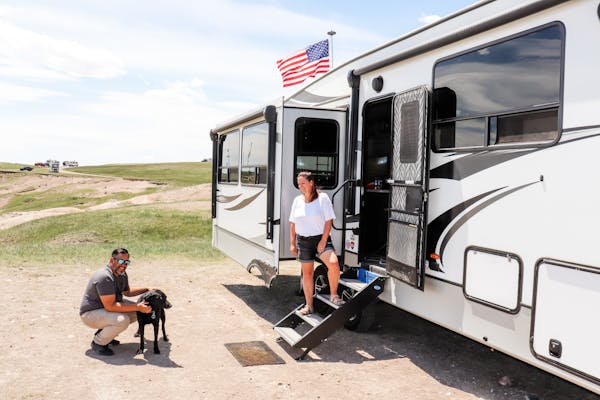Download A Route Planning App
The night before a travel day, we like to plan our driving route so we aren’t hitting the road blindly. One of our favorite apps is called RV Parky. This app not only allows us to plot a route but it also shows us areas and roads to avoid due to low clearance or narrow passages. Low clearance is always something to be aware of, especially if you have a taller RV like we do. Knowing the height of your RV (including any air conditioners, solar panels or roof racks) is essential for safe and successful travel days.
Route planning apps can also help you find places to stop along the way, including gas stations, restaurants, lodging, even businesses that allow overnight parking. If the app has user reviews, be sure and read those and check out any pictures to make sure you feel comfortable with the locations.
Look For Truck Stops
Our fifth wheel is 43 feet long and we tow it with a Ford F350 dually. So in total, we’re about 64 feet long when we roll down the highway. That makes our turning radius fairly wide, which can get tricky when we stop for gas. If you have a longer RV, or want a little more space, then we recommend looking for truck stops. Trucks stops are specifically built for big rigs and wide turns, and they almost always offer diesel. And while the price per gallon on diesel might be slightly more expensive at a truck stop compared to other gas station chains, we’ve found there are other benefits that help outweigh this cost.
First, truck stops often have extra large parking spaces, which allow us to pull over and use our own bathrooms. We can also open up the rig and make a quick lunch while we’re parked. Making our own lunches saves us money and can help compensate for the extra money we may have spent on gas. Another benefit of truck stops is that we’re able to let our dog out for a quick stretch. Some bigger truck stops even have dog parks, which are great for letting your dog burn off some energy before hitting the road again.

If You Leave Later, Plan To Stop Overnight
On travel days, we try to leave earlier in the morning to avoid driving at night. However, there are times when we have to work late and are unable to hit the road until later in the day. When this happens, I try to have everything packed and ready to go so we can leave as soon as we’re done. We’ll drive for a few hours and then stop at a Walmart or Cracker Barrell for the night. We’ve found this to be better than driving through the night or having one extra long travel day. Always call the business before you stop to make sure they actually allow overnight parking. While it’s not always necessary, we also like to purchase something from the business as a thank you for allowing us to utilize their parking lot for the night.
Be Mindful Of Your Mileage
When we first started RVing, we wanted to travel as many miles as possible in a day to maximize our time. We quickly learned that this wore us down, both physically and mentally. We ended up putting way more wear and tear on our RV and tow vehicle, and even dealt with a few tire blowouts.
We decided to start breaking up our drives and enjoy the experience of slower travel. Our family has found that if we travel 250-350 miles per day (roughly five hours), then we enjoy the experience a lot more. If our destination is 500-700 miles away, we’ll break that up into two travel days. On the first travel day, we’ll have a later start and drive less.
Then, on day two, we like to wake up early and hit the road right away. This allows the kids to sleep in the car and we can arrive at our destination with plenty of daylight.








